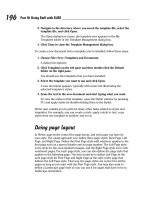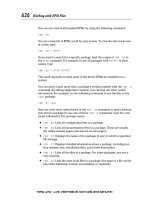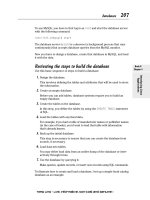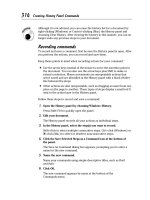Oracle PL/SQL for dummies phần 8 doc
Bạn đang xem bản rút gọn của tài liệu. Xem và tải ngay bản đầy đủ của tài liệu tại đây (821.2 KB, 44 trang )
In this part . . .
A
fter you’ve mastered some of the more basic concepts
and constructs of PL/SQL, this part includes a few
more advanced topics to enhance your coding knowledge.
Chapter 12 discusses the important interactions with the
database (commits, rollbacks, locks, and so on) and how
to handle problems that may occur.
Chapter 13 shows you how to use SQL and PL/SQL dynam-
ically to create very flexible applications where users can
select the operations to be executed at runtime.
Chapter 14 explains many coding best practices and
describes what to do to be a good PL/SQL programmer.
19_599577 pt05.qxp 5/1/06 12:16 PM Page 290
Chapter 12
Transaction Control
In This Chapter
ᮣ Handling transactions and data consistency
ᮣ Using commits and rollbacks
ᮣ Performing autonomous transactions
A
transaction is a logical unit of work that comprises a series of SQL data
manipulation statements. The COMMIT command permanently saves
the changes that all the SQL DML commands (data manipulation — INSERT/
UPDATE/DELETE) made during the current transaction to the database.
Conversely, a ROLLBACK command ends the transaction and undoes any
changes made.
This ability to commit a set of database events is one of the cornerstones of a
professional relational database. Many smaller, PC-based relational database
products don’t support this concept of a commit and are therefore unsuitable
for real-world applications. Problems occur when something unexpected hap-
pens. The unexpected event could be the power going out, the network being
interrupted, or even the application raising an unanticipated exception. When
this unexpected event occurs, execution stops, and it is possible that only
some of your database changes have been saved. How do you know what
went into the database and what didn’t? How do you get back to a stable point
and continue processing? Without a COMMIT statement to make the changes
made by a set of commands permanent, it is almost impossible to recover
from unexpected events.
In addition to normal transaction processes, Oracle has a specialized type
of transaction called an autonomous transaction. Autonomous transactions
enable you to temporarily halt a transaction in progress, perform some SQL
operations, either commit or roll back these transactions, and then return to
the main transaction.
This chapter discusses how transactions are controlled in Oracle as well as
how to leverage the power of autonomous transactions.
20_599577 ch12.qxp 5/1/06 12:16 PM Page 291
Using Transactions to Maintain
Data Consistency
Transactions are logical units of work containing one or more SQL statements.
The main purpose of transactions is to assist in keeping the environment logi-
cally consistent. For example, imagine that you want to do an electronic
funds transfer (EFT) to swap the amounts in two bank accounts.
Performing this sample EFT involves three SQL DML statements: one to debit
your account, one to credit the receiving account, and one to record the trans-
action for your monthly statement. What happens if the power goes out after
the system has processed the debit to your account, but before the money is
credited to the other account? Clearly, one of these actions cannot happen
without the other, and without the bank ending up with very unhappy (or very
happy) customers. The code to execute this transfer is shown in Listing 12-1.
Listing 12-1: Performing an Electronic Funds Transfer
begin
update account
➞
2
set balance = balance - 100
where acctno = 7902; Ford
➞
4
update account
➞
6
set balance= balance + 100
where acctno= 7499; –- Allen
➞
8
insert into txn_log
➞
10
(acctno, txn_type, amt)
values (7902, ‘DEBIT’, 100);
➞
12
end;
Additional details for Listing 12-1 are shown here:
➞
2–4 These lines subtract the transaction amount from Ford’s account.
➞
6–8 These lines add the transaction amount to Allen’s account.
➞
10–12 These lines log the transaction.
By introducing the concept of a transaction, Oracle tries to enforce that only
one of two things can happen when changes are being made: either they’re all
permanently saved to the database and visible to other users (committed),
or they’re rolled back and the data is unchanged. Transactions always start
with the first executable SQL statement and end when the application com-
mits or rolls back the changes.
292
Part V: Taking PL/SQL to the Next Level
20_599577 ch12.qxp 5/1/06 12:16 PM Page 292
The time that the user spends in front of a Web application or ATM to do the
fund transfer isn’t part of the database transaction. The transaction starts
after the payment has been specified and the user presses Submit to say,
“Okay, do it.”
When your code includes an UPDATE statement (as in Listing 12-1), Oracle
starts a new transaction and tries to identify what records are being changed.
Then it tries to lock the record so that no one else can do anything with it
until you’ve finished your modification. If somebody else is working with the
same record, Oracle either raises an exception or waits for a period of time
until the resource is free (depending on your database settings).
For example, if you’re trying to manipulate the record EMPNO=7902 (Ford),
Oracle does three things at once:
ߜ Copies the original version of the data you’re trying modify in the
buffers allocated for your session
ߜ Makes changes in your copy of the data
ߜ Creates a backup of changes in the REDO log buffers (in case Oracle
needs to replicate changes in the database itself)
When you started the transaction, your changes hadn’t yet been committed.
Therefore, for anyone else looking at the system, Jones’s account still has the
$100 in it. This happens because everybody else is reading from the data-
base, but you’re reading from your buffer first (the place where changes from
the previous step are located) and only after that do you read from the data-
base. The same process will occur for the second update. At that point, there
are two ways to proceed: You can save your changes (COMMIT) or discard
them (ROLLBACK).
Committing or Rolling Back
Changes to the Database
During a transaction, such as the one we describe in the preceding section,
choosing to COMMIT or ROLLBACK obviously affects your transaction.
If you decide to commit changes, the following things happen:
ߜ Changes are saved in the database and become visible to everyone.
ߜ All locks held during the transaction are released.
ߜ The transaction is marked as complete.
293
Chapter 12: Transaction Control
20_599577 ch12.qxp 5/1/06 12:16 PM Page 293
Rolling back means undoing any changes to data that have been made by
SQL statements within an uncommitted transaction. Both commits and roll-
backs come in two varieties: explicit and implicit. When you commit or roll-
back explicitly, you’re in the driver’s seat, telling Oracle what to do.
Implicit commits or rollbacks occur behind the scenes. A power failure or
exception may trigger them. Although you don’t necessarily have control
over when these happen, it’s nevertheless important to understand how
they’re connected to transaction control and keeping data consistent.
Firing explicit and implicit commits
Explicit commits are fired by using the COMMIT command, as shown in
Listing 12-2.
Listing 12-2: An Explicit Commit
begin
update ;
➞
2
update ;
➞
3
insert
➞
4
commit;
➞
5
end;
Here’s what’s going on in Listing 12-2:
➞
2–3 Changes made by both updates (lines 2 and 3) and the insert (line 5)
will be posted to the database when the commit is executed.
➞
5 This line executes the commit.
Implicit commits fire automatically when you use any DDL commands that
create, alter, or delete any database objects. It doesn’t matter if the DDL com-
mand fails. For example, if you try to create a unique index that contains non-
unique data, the command will fail but all prior activity is still committed. An
implicit commit is also executed when you send a request to terminate a ses-
sion in any one of a number of ways, such as using the EXIT command in
SQL*Plus or closing your connection.
Rolling back changes
Explicit rollbacks occur when you use the command ROLLBACK. The rollback
may be full or partial.
Assume that you wanted to discard all changes anywhere in your code where
an error was logged in the T_LOGERROR table. A full rollback of the whole
294
Part V: Taking PL/SQL to the Next Level
20_599577 ch12.qxp 5/1/06 12:16 PM Page 294
transaction, shown in Listing 12-3, discards all changes, releases all locks,
and marks the transaction “closed.”
Listing 12-3: A Full, Explicit Rollback
declare
v_errors_yn VARCHAR2(1) := ‘N’;
begin
update emp
set sal = sal * 1.1
➞
5
where deptNo = 10;
update emp
set sal = sal * .9
where deptNo = 20;
➞
9
lots more code where bad things might happen
select decode (count(*),
0,’N’,’Y’)
into v_errors_yn
from t_logError;
If v_errors_yn = ‘Y’ then
➞
17
rollback;
end if;
end;
➞
17 If the T_LOGERROR table contains any records, changes made by
both UPDATE statements (lines 5 and 9) will be discarded.
In a partial rollback, Oracle allows you to insert a marker in the transaction.
This marker is called the savepoint. In this case, you may roll back the most
recent changes in the transaction, as shown in Listing 12-4.
Listing 12-4: Adding a Partial Rollback
declare
v_errors_yn VARCHAR2(1) := ‘N’;
begin
update emp
set sal = sal * 1.1
➞
5
where deptNo = 10;
savepoint SaveDept10Update;
update emp
set sal = sal * .9
where deptNo = 20;
➞
10
lots more code where bad things might happen
select decode (count(*),
(continued)
295
Chapter 12: Transaction Control
20_599577 ch12.qxp 5/1/06 12:16 PM Page 295
Listing 12-4
(continued)
0,’N’,’Y’)
into v_errors_yn
from t_logError;
if v_errors_yn = ‘Y’ then
➞
18
Rollback to SaveDept10Update;
➞
19
end if;
end;
➞
18 If the condition is true, Oracle will discard changes and release all
locks made by the second update (line 10). However, changes
from the first update (line 5) will still be part of the current trans-
action. They can be saved or discarded independently of the cur-
rent rollback.
Names of savepoints follow the same naming rules and restrictions as vari-
able names, as we describe in Chapter 3.
You may create multiple savepoints in the same transaction, but keep in mind
that you will lose any transactions made after the specified one, as shown in
Listing 12-5.
Listing 12-5: Adding Savepoints
begin
update ;
➞
2
Savepoint A;
➞
3
update ;
➞
4
Savepoint B;
➞
5
update ;
➞
6
if condition then
➞
7
rollback to savepoint A;
➞
8
end if;
commit;
end;
If the condition in line 1 is true, the update in line 4 and line 6 will be dis-
carded. The savepoint at line 5 is irrelevant in this routine. Only the update at
line 2 will be committed when the COMMIT statement is reached.
If you do use multiple savepoints in one transaction, give all savepoints
unique, descriptive names. Although Oracle allows you to reuse a savepoint
name, we recommend avoiding this. Reusing a savepoint name will make it
difficult to determine which savepoint was actually the most recent one
encountered.
Rolling back to a savepoint only discards changes to the database; it does not
undo any changes you made to local PL/SQL variables.
296
Part V: Taking PL/SQL to the Next Level
20_599577 ch12.qxp 5/1/06 12:16 PM Page 296
Knowing when to use implicit rollbacks
Oracle uses implicit rollbacks in special cases to maintain data consistency.
A statement-level rollback is fired if a SQL statement causes an error at any
time during execution. This type of rollback causes the code to execute as if
that statement had never been run. This means that all locks acquired for the
failed statement are released.
Listing 12-6 attempts to place 11 characters into the column eName defined
as VARCHAR2(10).
Listing 12-6: Code Requiring a Rollback
begin
update emp
set eName=rpad (eName,10,’*’)
➞
3
where empNo=7369;
update emp
set eName=rpad (eName,11,’*’)
➞
6
where empNo=7499;
end;
➞
6 The second update will fail because eName is only ten characters
long, but the critical thing to recognize is that there will be no
locks in the record of employee 7499. Anyone else can edit
employee 7499 and commit the changes while the routine is run-
ning. Employee 7369 is locked while the routine is running. No one
will be able to modify that record until the routine terminates or
releases its lock.
A transaction-level rollback is fired when a session is terminated abnormally.
This can happen for many reasons:
ߜ You mistakenly turn off your computer. For Web applications, this usu-
ally doesn’t terminate the session until the application server times out
your process.
ߜ A DBA terminates your session.
ߜ Your session terminates because of an unhandled exception (see
Chapter 5 for a full discussion of exceptions).
ߜ The Oracle database goes down.
ߜ Your connection to the database is lost.
When any of these events occur, all uncommitted changes are lost.
297
Chapter 12: Transaction Control
20_599577 ch12.qxp 5/1/06 12:16 PM Page 297
A transaction-level rollback of all outstanding transactions is fired in the case
of a database crash. In that case, powering down the server will cause any
uncommitted data for all users connected at that moment to be discarded.
Resolving deadlocks
There is one more situation where a rollback might be necessary. A deadlock
can occur when two or more users are waiting for a resource locked by each
other. For example, suppose user 1 locks customer A and then tries to lock
customer B and at the same time, and user 2 locks customer B and then tries
to lock customer A. Then user 1 waits for user 2 to unlock customer B and
user 2 waits for user 1 to unlock customer A. This is a deadlock. Oracle resolves
it by raising a deadlock exception (ORA-00060: deadlock detected while
waiting for resource) in user 1’s session. This terminates the procedure
and allows user 2’s procedure to successfully complete.
Deadlocks are rare, and the Oracle DBMS is pretty good at detecting dead-
locks. When a deadlock is encountered, instead of waiting forever for the situ-
ation to resolve itself, Oracle will terminate one of the sessions (causing a
rollback) to resolve the deadlock.
It isn’t very likely that you’ll ever encounter this problem. But deadlocks do
happen from time to time. If you use autonomous transactions a lot (as we
describe in the next section), you’ll have a higher chance of running into a
deadlock situation.
Autonomous Transactions
Oracle has the ability to suspend the execution of a transaction and transfer
execution control to an independent child transaction. This child transaction
is called an autonomous transaction. An autonomous transaction is completely
independent of the calling transaction, which means that it doesn’t share
resources, locks, or any commit dependencies with the main transaction.
Autonomous transactions can include just as much functionality as any other
database transactions. They’re very useful for creating software components
that can be reused in numerous applications.
One advantage of using an autonomous transaction is that DML can be exe-
cuted and committed, even if the main transaction is rolled back. For exam-
ple, a row can be inserted in a transaction log, recording which data was
accessed, even if the user doesn’t update any of the data. This is a very
useful feature for auditing and security.
298
Part V: Taking PL/SQL to the Next Level
20_599577 ch12.qxp 5/1/06 12:16 PM Page 298
Setting up the syntax for an
autonomous transaction
Before we show you an example of autonomous transaction in context, it’s
helpful to know the syntax, which is outlined in Listing 12-7.
Listing 12-7: Autonomous Transaction Syntax
declare
pragma autonomous_transaction;
➞
2
begin
➞
3
number of statements
commit;(or rollback;) – End of transaction 1
➞
7
number of statements
commit;(or rollback;) – End of transaction 2
end;
Here are more details about Listing 12-7:
➞
2 Begins an autonomous transaction. This command indicates that
the autonomous transaction starts from the BEGIN statement of
the block (line 3) in which the pragma statement is found. From
this point until the end of the transaction, all PL/SQL blocks (func-
tions, procedures, anonymous blocks, and triggers) belong to that
new transaction.
The END statement doesn’t close the autonomous transaction
automatically. The transaction must be closed explicitly by issu-
ing a COMMIT, ROLLBACK, or any command including an implicit
commit. If one of these commands isn’t executed and the block
defined as an autonomous transaction ends, the Oracle RDBMS will
roll back the entire transaction and raise an error with the follow-
ing message: ORA-06519: active autonomous transaction
detected and rolled back.
➞
7 If the transaction ended but the block defined as autonomous
didn’t finish, the new transaction also will be autonomous.
A pragma autonomous transaction (a PL/SQL compiler directive to define an
autonomous transaction) can be used in the declaration part of the following:
ߜ Top-level anonymous blocks
ߜ Local, standalone, or packaged functions and procedures
299
Chapter 12: Transaction Control
20_599577 ch12.qxp 5/1/06 12:16 PM Page 299
ߜ Database triggers
ߜ Methods of object types
Handling auditing and security with
autonomous transactions
Using the auditing and security example, when dealing with highly secure
data such as the SAL (salary) column in the EMP table of an Employee data-
base, you want to be aware of any modifications made to that column. There
are several ways to try to do this. One obvious thing you can try that won’t
work is to create a trigger and a special procedure that would log the infor-
mation into a special table, as shown in Listing 12-8.
Listing 12-8: Non-Working p_log_audit
create sequence audit_seq
/
Create table audit_emp (action_nr NUMBER,
action_cd VARCHAR2(2000), descr_tx VARCHAR2(2000),
user_cd VARCHAR2(10), date_dt DATE)
/
Create or replace procedure p_log_audit
(what_tx VARCHAR2, descr_tx VARCHAR2,
who_tx VARCHAR2, when_dt DATE) is
begin
insert into audit_emp
values(audit_seq.nextval, what_tx, descr_tx,
who_tx, when_dt);
commit;
➞
15
end;
/
create or replace trigger bu_emp
before update of sal on emp
referencing new as new old as old for each row
begin
p_log_audit (‘update’,
‘update of emp.salary’, user, SYSDATE);
end;
/
➞
15 The COMMIT command in the procedure p_log_audit should
post the inserted data to the permanent storage even if the update
to the employee table fails.
If you try to increase the salary of employee 7900, you get an error, as shown
in Listing 12-9.
300
Part V: Taking PL/SQL to the Next Level
20_599577 ch12.qxp 5/1/06 12:16 PM Page 300
Listing 12-9: Error from COMMIT in a Trigger
SQL> update emp set sal=10000 where empNo=7900;
update emp set sal=10000 where empNo=7900
*
ERROR at line 1:
ORA-04092: cannot COMMIT in a trigger
ORA-06512: at “SCOTT.P_LOG_AUDIT”, line 9
ORA-06512: at “SCOTT.BU_EMP”, line 2
ORA-04088: error during execution of trigger
‘SCOTT.BU_EMP’
From the error, you can see that you aren’t allowed to perform a commit in
the trigger. The current transaction wasn’t completed, so it isn’t possible to
post changes and initialize the new transaction.
Because using this method can’t solve the problem, you need to use another
strategy to execute one set of commands independently from another.
However, the commands should be in the same session and share the same
session resources. This is a good place to use an autonomous transaction, as
shown in Listing 12-10, which shows the corrected p_log_audit procedure
that can be called in a trigger.
Listing 12-10: p_log_audit as Autonomous Transaction
create or replace procedure p_log_audit
(what_tx VARCHAR2, descr_tx VARCHAR2,
who_tx VARCHAR2, when_dt DATE)
is
pragma autonomous_transaction;
begin
insert into Audit_emp
values(audit_seq.nextval, what_tx, descr_tx,
who_tx, when_dt);
commit;
end;
When you run this code, you get the following result:
SQL> update emp set sal=10000 where empno=7900;
1 row updated.
SQL> select action_nr, action_cd, user_cd, date_dt
2 from audit_emp;
ACTION_NR ACTION_CD USER_CD DATE_DT
2 update SCOTT 08-JUL-05
There are no errors, and the change was logged. But what happens if you roll
back the update?
301
Chapter 12: Transaction Control
20_599577 ch12.qxp 5/1/06 12:16 PM Page 301
SQL> rollback;
Rollback complete.
SQL> select sal from emp where empno=7900;
SAL
950
SQL> select action_nr, action_cd, user_cd, date_dt
2 from audit_emp;
ACTION_NR ACTION_CD USER_CD DATE_DT
2 update SCOTT 08-JUL-05
In this situation, the update of the salary was rolled back (it is still 950, not
10000), but the log wasn’t changed, which means that you have a mecha-
nism to track any transaction activity, regardless of the main activities.
To achieve the output shown above, the code works in five steps:
1. The UPDATE statement fires the trigger BU_EMP.
2. The trigger calls the function p_log_audit (still in the same
transaction).
3. The declaration block of the procedure still belongs to the main trans-
action; however, the database found the line pragma autonomous_
transaction. This means that from the next BEGIN statement, it
should start a new transaction in the current session.
4. Inside the autonomous transaction, a new record was inserted into the
table AUDIT_EMP, and the change was committed. The commit only
makes changes in this transaction permanent. It is completely indepen-
dent from the parent transaction, and any data updated in the parent
transaction still isn’t committed.
5. When the autonomous transaction ends, because the insert has been
committed, the database can properly return to the main transaction
and the trigger from which the procedure was called.
Autonomous transaction features
To be able to properly describe an autonomous transaction, we compare it
with nested transactions. Nested transactions occur when any function, proce-
dure, method, or anonymous block is called within another block or trigger
and the called procedure is not autonomous.
One of the really interesting things about nested transactions is that there is
nothing interesting about them. If there is an INSERT, UPDATE, or DELETE
command in a procedure, and then a second INSERT, UPDATE, or DELETE
302
Part V: Taking PL/SQL to the Next Level
20_599577 ch12.qxp 5/1/06 12:16 PM Page 302
command in a function is called by that procedure, and then a third INSERT,
UPDATE, or DELETE command in an anonymous PL/SQL block is in the called
function, Oracle treats these transactions as though those three commands
were right next to each other in your code. It is all one database transaction
(even divided into a number of nested ones). What is going on behind the
scenes is very complex, but you need not even be aware that this concept
of a nested transaction exists. Everything is transparent to the developer.
However, when you make a called function or procedure autonomous, it is a
very different thing.
What are the differences between autonomous and nested transactions? One
of the main differences is how autonomous and nested transactions treat
scope. The concept of scope is defined as the ability to see values of various
things within the database. These “things” could be variables, data changes,
locks, settings, exceptions, and so on. It is important to understand how dif-
ferent Oracle constructs behave on different levels (session/transaction) and
in different contexts (autonomous/nested transactions).
Data changes
The most critical aspect of any system functionality is what happens to your
data. That question is bidirectional: What happens to changes in the main
transaction? What happens to changes in the autonomous one?
As an example, Listing 12-11 is a small routine that will print out a number of
records in the table AUDIT_EMP.
Listing 12-11: Autonomous Transaction
create or replace procedure p_data_change_test is
v_nr NUMBER;
pragma autonomous_transaction;
begin
select count(1) into v_nr from audit_emp;
➞
5
DBMS_OUTPUT.put_line (‘Count=’||v_nr);
➞
6
end;
/
delete from audit_emp
➞
8
/
commit
➞
10
/
Here are the details about Listing 12-11:
➞
5–6 These lines fetch the records.
➞
8 To simplify the example, all records have been removed from the
audit-emp table and the change committed (line 10).
303
Chapter 12: Transaction Control
20_599577 ch12.qxp 5/1/06 12:16 PM Page 303
The following routine inserts a record into AUDIT_EMP (line 2). After that, the
p_data_change_test procedure will be called (line 3).
SQL> begin
2 insert into audit_emp (action_nr) values (100);
3 p_data_change_test;
4 end;
5 /
Count=0
PL/SQL procedure successfully completed.
SQL>
But there’s a surprise. Inside the autonomous transaction, Oracle doesn’t see
a new record inserted from the parent transaction. Because of the data con-
sistency, Oracle spawns an autonomous transaction as of the last stable
moment. That moment is exactly the beginning point of the parent transac-
tion. This is the reason why no uncommitted changes from the parent trans-
action are visible to the autonomous one.
What happens with data changes that are inside autonomous transactions?
To answer this question, some additional definitions are needed:
ߜ Isolation level: The degree to which the intermediate state of the data
being modified by a transaction is visible to other concurrent transac-
tions (usually from a different session); and, the data being modified by
other transactions is visible to the current transaction.
ߜ Isolation level = Read committed: A transaction rereads data that it has
previously read and finds that another committed transaction has modi-
fied or deleted the data. This means that if somebody else changes the
data after you connected to the database (starting the transaction),
you’ll see these changes.
ߜ Isolation level = Serializable: The transaction can’t see any changes in
other transactions that have been processed after it started. In that
case, until you start a new session/transaction, you’ll see exactly what
data existed in the database at the moment you connected.
Listing 12-12 includes another routine that still the clears table before each test.
Listing 12-12: Autonomous Transaction with Data Changes
create or replace procedure p_commit_test is
pragma autonomous_transaction;
begin
insert into audit_emp(action_nr) values(100);
➞
4
commit;
➞
5
end;
➞
6
/
➞
7
304
Part V: Taking PL/SQL to the Next Level
20_599577 ch12.qxp 5/1/06 12:16 PM Page 304
delete from audit_emp
/
commit
/
Listing 12-12 works like so:
➞
4 The first test will be with the default Oracle setting (READ_
COMMITTED). That routine calls p_commit_test (line 5).
➞
5 Inserts one record in the table AUDIT_EMP and checks the total
number of records in the same table after the execution (lines 6–7).
The result of running Listing 12-12 is as follows:
SQL> declare
2 V_nr NUMBER;
3 begin
4 set transaction isolation level read committed;
5 p_commit_test;
6 select count(*) into v_nr from audit_emp;
7 DBMS_OUTPUT.put_line (‘Count=’||v_nr);
8 end;
9 /
Count=1
PL/SQL procedure successfully completed.
There are no surprises here. Oracle successfully detected the new record.
Now you can clean the table one more time and try another option, namely
the SERIALIZABLE (line 10) in the following code:
SQL> delete from audit_emp;
1 row deleted.
SQL> commit;
Commit complete.
SQL> Declare
2 v_nr NUMBER;
3 Begin
4 set transaction isolation level serializable;
➞
10
5 p_commit_test;
6 select count(*) into v_nr from audit_emp;
7 DBMS_OUTPUT.put_line (‘Count=’||v_nr);
8 End;
9 /
Count=0
PL/SQL procedure successfully completed.
The result is indeed a surprise. For the Oracle, there is no difference between
an autonomous transaction and transactions from another session in the con-
text of data visibility.
305
Chapter 12: Transaction Control
20_599577 ch12.qxp 5/1/06 12:16 PM Page 305
Locks
Autonomous transactions can be tricky. From the experience of working with
isolation levels, it is clear that data changes can be troublesome. But what
about locking (not updating) the record in the table? Some front-end tools
might place a lock on the record that you just modified and keep that lock for
some time. This can sometimes cause problems. For example, you might have
a simple routine that gives a specified employee a 10 percent salary raise,
which is defined as an autonomous transaction, as shown in Listing 12-13.
Listing 12-13: A Locking Example
create or replace procedure p_raise (i_empNo number)
is
pragma autonomous_transaction;
begin
update emp
set sal=sal*1.1
where empNo=i_empNo;
commit;
end;
Now you will try to lock the needed record for update (to be sure that nobody
else touches it) and modify salary by using the newly created procedure
p_raise:
SQL> declare
2 v_emp_rec emp%ROWTYPE;
3 begin
4 select *
5 into v_emp_rec
6 from emp
7 where empNo = 7900
8 for update;
➞
8
9 p_raise (7900);
➞
9
10 end;
11 /
declare
*
ERROR at line 1:
ORA-00060: deadlock detected while waiting for resource
ORA-06512: at “SCOTT.P_RAISE”, line 5
ORA-06512: at line 10
Here’s what happens in the preceding code:
➞
8 Lock the whole record for update.
➞
9 Calls procedure p_raise.
306
Part V: Taking PL/SQL to the Next Level
20_599577 ch12.qxp 5/1/06 12:16 PM Page 306
The last action creates a deadlock within the same session. Because the
record was locked for update in the parent transaction (started with anony-
mous block), the autonomous transaction (started in the procedure p_raise)
was waiting for its turn. It needed to have its own row-level lock to perform an
update. But the parent transaction couldn’t release a lock because it was wait-
ing for the autonomous one to finish. As a result, the deadlock is obvious.
When using any autonomous transaction routines, you need to understand
locking because locks are transaction-level resources and not shared across
transactions.
Exceptions
If changes in the autonomous transaction aren’t committed or rolled back
when the transaction ends, Oracle will raise an error and roll back the whole
transaction. It is just a matter of habit to close all autonomous transactions
appropriately. But it is possible that something in the autonomous transac-
tion went wrong. What happens to uncommitted changes?
To answer that question, the procedure p_rollback_test, which contains
two UPDATE statements, is shown in Listing 12-14.
Listing 12-14: Handling Uncommitted Changes Using rollback_test
create or replace procedure p_rollback_test is
pragma autonomous_transaction;
begin
update emp
set eName=rpad (ename,10,’*’)
➞
5
where empNo=7369;
update emp
set eName=rpad (ename,11,’*’)
➞
8
where empNo=7499
commit;
end;
Here’s what Listing 12-14 is doing:
➞
5 This statement is okay.
➞
8 Tries to place an 11-character string into the field ENAME defined
as VARCHAR2(10).
In the parent transaction, an exception handler catches the raised exception
and length of the column ENAME that should be modified by the first update.
(Recall the example in Listing 12-6 with statement-level rollbacks.) The result
of running the code in Listing 12-14 is as follows:
307
Chapter 12: Transaction Control
20_599577 ch12.qxp 5/1/06 12:16 PM Page 307
SQL> delete from audit_emp;
1 rows deleted.
SQL> commit;
Commit complete.
SQL> declare
2 v_tx VARCHAR2(256);
3 begin
4 p_rollback_test;
5 exception
6 when others
7 then
8 select eName into v_tx from emp
9 where empNo = 7369;
10 DBMS_OUTPUT.put_line(‘Error:’||sqlerrm);
11 DBMS_OUTPUT.put_line(‘eName=’||v_tx);
12 end;
13 /
Error:ORA-01401: inserted value too large for column
Ename=SMITH
PL/SQL procedure successfully completed.
This produced another unexpected result; namely, eName remained the same. In
most cases, it should become SMITH, but exceptions raised in an autonomous
transaction caused a transaction-level rollback rather than a statement-level
rollback. This means that all uncommitted changes in the autonomous transac-
tion will be lost if the exception propagates to the parent level.
Applying autonomous transactions
to other real-world situations
Autonomous transactions can be extremely powerful when used properly.
The following are some real-world examples of when they can be used.
Activity audit
Listing 12-8, where you create a log of anyone modifying the SAL column,
could be rewritten more simply with just a trigger. Triggers by themselves
can be defined as autonomous transactions, as shown here:
create or replace trigger emp_bu
before update of sal on emp
referencing new as new old as old for each row
declare
pragma autonomous_transaction;
begin
insert into audit_emp values(audit_seq.nextval,
‘update’, ‘update of emp.salary’,user, SYSDATE);
commit;
end;
308
Part V: Taking PL/SQL to the Next Level
20_599577 ch12.qxp 5/1/06 12:16 PM Page 308
However, defining triggers as autonomous transactions might create dead-
locks. If you want to add the business rule “If salary was decreased, commis-
sions should be increased by half of the difference” to your code, the most
straightforward solution would look like the following:
create or replace trigger emp_bu
before update of sal on emp
referencing new as new old as old for each row
declare
pragma autonomous_transaction;
begin
insert into audit_emp
values(audit_seq.nextval, ‘update’,
‘update of emp.salary’, user, SYSDATE);
if :new.sal < :old.sal then
update emp
set comm=(:new.sal-:old.sal)/2
where empNo=:new.empNo;
end if;
commit;
end;
The problem is that the solution is wrong and produces this output:
SQL> update emp
2 set sal = 400
3 where empNo = 7369;
update emp
*
ERROR at line 1:
ORA-00060: deadlock detected while waiting for resource
ORA-06512: at “SCOTT.BU_EMP”, line 8
ORA-04088: error during execution of trigger
‘SCOTT.BU_EMP’
SQL>
The reason for the failure is very simple: Oracle already locked the record
you’re trying to update in the main transaction. When you spawned the
autonomous one, you were trying to update exactly the same record.
However, the main transaction waits for the trigger to complete before releas-
ing the lock, thus resulting in a deadlock.
Query audit
Some situations require more than simple data modification. For example you
may need to know who queries the SAL column from the table EMP. To
retrieve this information, you can create a special function (f_log_nr), as
shown in Listing 12-15.
309
Chapter 12: Transaction Control
20_599577 ch12.qxp 5/1/06 12:16 PM Page 309
Listing 12-15: Query Audit Function
create or replace function f_log_nr (v_value_nr NUMBER)
return number is
pragma autonomous_transaction;
begin
insert into audit_emp (action_nr, user_cd, date_dt)
values (audit_seq.nextval, user, SYSDATE );
➞
6
commit;
➞
7
return v_value_nr;
➞
8
end;
/
Here’s what goes on in Listing 12-15:
➞
6–7 Logs the activity into audit table.
➞
8 Returns exactly the same value it receives as a parameter.
You then need to create a special view (V_EMP) that looks exactly like the
EMP table with one small difference. Instead of the column SAL, use the func-
tion f_log_nr with the SAL column passed into it. The code to create the
view is shown here:
create or replace view v_emp as
select empNo, eName, deptNo, job, mgr, f_log_nr (sal) sal
from emp;
Because the function is defined as an autonomous transaction, you can use it
in a SELECT statement, even though it has DML inside. Exception ORA-14551
will not be raised in that case, because the transactions are consistent. There
are just two of them.
In SQL, you can use functions that do absolutely anything if they are defined
as autonomous transactions. Just be very careful.
The function returns exactly the same value it received, so from the user’s
point of view, there is no change. But logs are generated each time the func-
tion is called, so a log is generated for each row retrieved from the database,
which is exactly what you wanted.
Self-mutating transaction problems
To implement the business rule “An Employee’s commissions cannot exceed
the salary of his/her manager,” check out the following direct solution:
create or replace trigger emp_bu
before update of comm on emp
referencing new as new old as old for each row
declare
v_sal_nr NUMBER;
310
Part V: Taking PL/SQL to the Next Level
20_599577 ch12.qxp 5/1/06 12:16 PM Page 310
begin
select sal into v_sal_nr
from emp
where empNo=:new.mgr;
if :new.comm > v_sal_nr then
raise_application_error(-20999,
‘Commissions are too high!’);
end if;
end;
The problem is that you’re trying to access the same table you’re updating. In
this case, Oracle has no way of ensuring that the data is consistent in the cur-
rent transaction and just gives up, as shown here:
SQL> update emp
2 set comm = 10000
3 where empNo = 7369;
update emp
*
ERROR at line 1:
ORA-04091: table SCOTT.EMP is mutating, trigger/function
may not see it
ORA-06512: at “SCOTT.BU_EMP”, line 4
ORA-04088: error during execution of trigger
‘SCOTT.BU_EMP’
SQL>
To allow Oracle to maintain consistency, use the code shown in Listing 12-16.
Listing 12-16: Code Using an Autonomous Transaction
create or replace trigger emp_bu
before update of comm on Emp
referencing new as new old as old for each row
declare
pragma autonomous_transaction;
➞
5
v_sal_nr NUMBER;
begin
select sal into v_sal_nr
from emp where empNo=:new.mgr;
if :new.comm > v_sal_nr then
raise_application_error(-20999,
‘Commissions are too high!’);
end if;
end;
➞
5 Wraps the trigger in an autonomous transaction. No data modifi-
cations take place inside of the trigger so you aren’t required to
place COMMIT at the end.
311
Chapter 12: Transaction Control
20_599577 ch12.qxp 5/1/06 12:16 PM Page 311
Now you get the expected result:
SQL> update emp set comm = 10000 where empno = 7369;
update emp
*
ERROR at line 1:
ORA-20999: Commissions are too high!
ORA-06512: at “SCOTT.BU_EMP”, line 8
ORA-04088: error during execution of trigger
‘SCOTT.BU_EMP’
SQL>
When resolving self-mutation issues with autonomous transactions, don’t use
this approach if you want to query the same column you’re updating. The
business rule “The salary of the employee should not exceed the salary of
his/her manager” must be implemented procedurally rather than in the trig-
ger for the following reasons. Assume you’re updating a set of records at one
time by using this code:
update emp set sal=sal*1.1 where deptNo=10
Because you’re updating salaries for the whole department, the salary of both
the lower-level employee and his or her manager will be changed. But the
autonomous transaction won’t know about these changes, because it starts
with the dataset that existed at the beginning of the main transaction (that is,
before the update was fired). This means that you can compare the salary of
the employee only with the original salary of the manager because the new
one hasn’t yet been posted. There is no simple solution for this problem.
312
Part V: Taking PL/SQL to the Next Level
20_599577 ch12.qxp 5/1/06 12:16 PM Page 312
Chapter 13
Dynamic SQL and PL/SQL
In This Chapter
ᮣ Understanding native dynamic SQL
ᮣ Using the EXECUTE IMMEDIATE command
ᮣ Using OPEN FOR — dynamically defined cursors
W
hen writing code in most situations, you know what database informa-
tion must be accessed and how the information might be manipu-
lated. Using the simple Employee and Department example, you know what
tables and columns are being used and/or changed, what criteria are used to
select rows, and the column datatypes. However, in some cases, the clauses,
commands, variable datatypes, number of variables, and database object ref-
erences aren’t known prior to compiling the code. In these cases, the code
must be created at runtime and will change each time the program is exe-
cuted. These code statements are dynamic.
Dynamic SQL and PL/SQL allow you to create very flexible applications,
where users can select which operations, tables, columns, and so on are
involved. This chapter shows how you can build queries, pieces of PL/SQL
code, or even whole procedural routines on the fly.
Taking Advantage of Dynamic SQL
Having many (perhaps hundreds) of repetitive elements in your logic often
causes problems. For example, you might have a huge table with 100 columns
and a set of reports, each of which requires 2 or 3 columns, but not the whole
set. Or each calendar quarter, you need to archive the data into a separate
table. Or you need to build code to query archived information, but the table
doesn’t exist at the moment you’re writing the code.
These situations would be extremely difficult to handle by using regular SQL
or PL/SQL. For these cases, you can use the powerful feature Native Dynamic
SQL (also called dynamic SQL). Native Dynamic SQL allows you to build SQL
or PL/SQL statements dynamically by using text strings and some additional
command syntax and by processing the statements at runtime.
21_599577 ch13.qxp 5/1/06 12:16 PM Page 313
The sections in this chapter discuss some of the ways in which Native
Dynamic SQL can help you create more efficient code to handle specific prob-
lems, including the following:
ߜ Querying SQL tables in many different ways and keeping the code efficient
ߜ Building a generic data viewer so that you can enter parameters on the
fly and see data in different ways, based on those parameters
ߜ Creating DDL on the fly so you have a generic routine that works with
any database object
A Simple EXECUTE IMMEDIATE
Eighty percent of all dynamic SQL is covered by some fairly simple com-
mands that include EXECUTE IMMEDIATE. Here are a couple of examples:
begin
execute immediate ‘whatever_text_string_you_want’;
end;
or
declare
v_variable_tx VARCHAR2(32000);
begin
v_variable_tx:=’whatever_you_want’;
execute immediate v_variable_tx;
end;
From a syntax point of view, the following points are important:
ߜ Only one command, EXECUTE IMMEDIATE, is used.
ߜ The code to be executed can be passed as a variable or directly as a
string in the command.
ߜ The string cannot exceed 32K. The code can range from a single SQL
command to a large block of PL/SQL. So, although 32K is generous, it
might not be sufficient for all purposes. If you need to work with large
strings, Oracle’s DBMS_SQL package is available, but it is significantly
less convenient than Native Dynamic SQL.
ߜ All PL/SQL blocks passed as a string should have a semicolon at the end,
as shown here:
execute immediate ‘begin p_test; end;’;
ߜ All SQL statements passed as a string should not have a semicolon at
the end, as shown here:
execute immediate ‘select 1 from dual’ into a;
314
Part V: Taking PL/SQL to the Next Level
21_599577 ch13.qxp 5/1/06 12:16 PM Page 314









